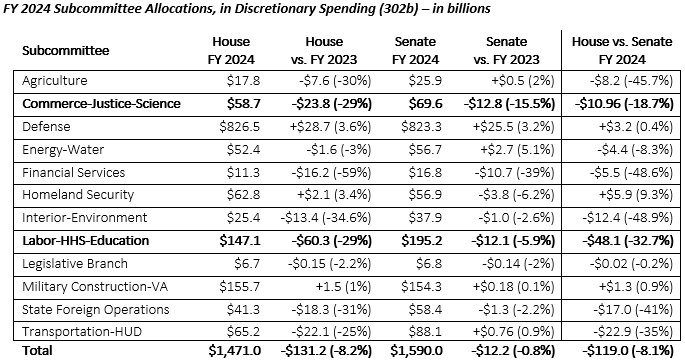FY 2024 Funding Bills Advance, Outlook is Still Murky
As previously reported, lawmakers on Capitol Hill have started moving fiscal year (FY) 2024 appropriations bills in recent weeks. The House Appropriations Committee has reported out five of its 12 appropriations bills, including those covering funding for agriculture, defense, energy and water, homeland security, and legislative branch activities. The Senate committee recently approved two bills dealing with military construction/veteran’s affairs and agriculture. On the surface, progress appears to be moving at a decent pace. However, bigger political pressures continue to bog down the annual appropriations process, creating lots of uncertainty about the path forward.
Last week before considering its funding for two bills, the Senate Appropriations Committee voted along party lines to approve its FY 2024 subcommittee allocations, known as 302(b). These are top-line funding levels that are provided to each of the 12 appropriations subcommittees, setting the parameters for how much discretionary funding each can spend in their respective bills.
According to the allocations (see table below), the Democrat-controlled Senate plans to write its bills to comport with the overall budget cap set in the debt limit agreement brokered last month ($1.59 trillion in discretionary spending), which includes $886.3 billion in defense spending and $703.7 billion in nondefense spending.
However, as previously reported, Republican leadership in the House has chosen to cut FY 2024 spending below the amount set in the agreement ($1.47 trillion for discretionary spending, with most cuts coming from non-defense accounts). You can see in the table below how priorities differ between the House and Senate.

Congress is currently out on a two-week recess for the Independence Day holiday. When they return, the Appropriations Committees are expected to continue working through their bills, with an eye toward bringing as many to their respective floors for a vote before the month-long August recess. The next tranche of bills to be considered is expected to include the Commerce, Justice, Science, and Related Agencies (CJS) bill, which funds the National Science Foundation, Department of Justice, Census Bureau, and other federal agencies and programs. There is a nearly $11 billion difference between the House and Senate allocations for the CJS bill.
The other bill important to the science community is the Labor, Health and Human Services, Education, and Related Agencies (LHHS) bill, which funds the National Institutes of Health and other agencies within the Department of Health and Human Services, the Department of Education, and several federal statistical agencies. However, the LHHS bill tends to be one of the last considered given that it contains several accounts related to social assistance programs and other polarizing topics like reproductive health and LGBTQIA+ provisions. Underscoring the partisan divide when it comes to the LHHS bill, there is a $48 billion difference between the House and Senate allocations for this bill.
At this stage, the endgame remains unclear given the ongoing dispute between the two chambers. The new fiscal year begins October 1, which suggests that a continuing resolution (CR) will likely be needed to keep the government open until the FY 2024 process can be completed.
Stay tuned to COSSA’s coverage for all the details.

